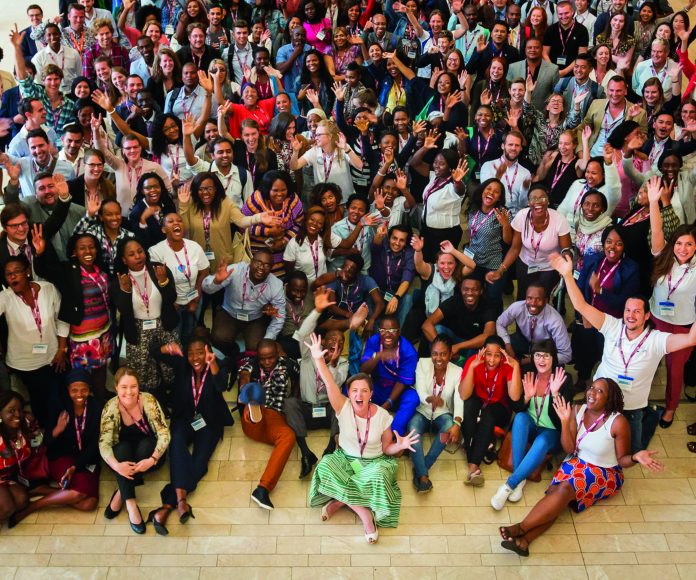Emerging water leaders are eager to jump ahead and set the agenda for 2050 and beyond. By Kirsten de Vette
At the latest International Young Water Professionals Conference in South Africa, young men and women shifted in their seats as they listened to drought-struck Cape Town’s authorities talk about the approach of Day Zero. They fidgeted as Argentina’s senior officials rolled out the country’s comprehensive Water Policy and grew restless as elder statesmen discussed how to speed up attaining water’s Sustainable Development
Goal (SDG 6).
Why so much impatience?
While middle-aged city, national, and global officials were there to set a three-month, five-year, or decadal agenda, the ambitions of Young Water Professionals around them focused far more intensely on shaping what our world will look like in 2050.
Are they not proceeding too quickly, rushing forth prematurely and causing waste from haste? To the contrary, says Geci Sebina Karura of the South African Cities Network, water professionals risk far more from making the common mistakes of duplication of investment across cycles and sectors. They need to avoid planning too late for massive changes that will require “a complete change in mindset”.
To that end, at the conference, Karura and other emerging water leaders refused to wait until after 2030, to discuss the hard decisions about what approaches they should implement. Instead, they argued, that we should start planning for the postSDGs, immediately. Here are a few examples of why some can’t wait, and what they plan to do.
Lloyd Fisher-Jeffes
Aurecon Ltd, South Africa
A volatile climate and growing population make water scarce, putting our thirsty, hungry and energy-starved world at risk. The ideal response is to improve data collection and
interpretation, then share cogent analyses with decision makers so they can plan in advance rather than respond to sudden crises.
The reality is different. The crushing drought here in Cape Town looms as the ‘new normal’, leading to urgent calls for costly desalination plants. Such investments may be appropriate, and the only realistic and most reliable option. But how do we know? Would such a decision be based on good data and proper analyses?
It may be a short-term reaction to fear, since data shows the region won’t face less water, just the same amount falling on fewer days.
Given limited models, water system engineers and resource planners must design for the future from a position of uncertainty. The cash-poor city can’t afford to build energy-intensive plants that may fall into disuse.
So instead of taking salt out of the sea, perhaps we should invest more in freshwater recycling and reuse. Cape Town’s drought fee is already higher than standard water rates, so we need to be confident that the economic impacts of running out of water will be worse than the increasing cost of supplying it.
 Suvritha Ramphal
Suvritha Ramphal
Danish Embassy, South Africa
Water utilities hoping to meet the SDG 6 targets must increase efficiency standards, take conservation measures, and charge more per unit, while at the same time accepting
declining sales and rising costs. Both unexpected and unplanned, this ‘new normal’ places increased pressure on utilities to evolve and adapt their financial model at a much faster pace than before, hitting targets that seem to change faster than they can be monitored and reported on.
At this pace, what future conditions and challenges must utilities endure? By 2030 the thirstiest people (8.5 billion) in a warmer world will face extreme water scarcity. In response, I predict that water utilities will reconfigure their financial model to reflect the true cost of this fast depleting resource, just as the UN announces “ambitious new targets” under the Resilient Development Goals (RDGs).
If that is coming anyway, why wait another twelve years? Instead, let’s advance the new normal now, in two steps. First, diversify a utility’s revenue stream to reduce dependence on subsidies and on the sale of a single commodity, water. Second, increase its revenue potential to not only cover costs but also to allow for a long-term stable resilient model.
That means investigating wastewater reuse for water, recovering fertiliser and energy resources from wastewater, and seeking and advancing to become energy neutral
through symbiotic relationships between industries and energy and water utilities. To deliver services, utilities can use waste generated from one process as an input into another.
 Rianna Gonzales
Rianna Gonzales
Water Resources Agency,
Trinidad and Tobago
By 2050, 70 percent of the world’s 9.8 billion people will live in urban areas, putting pressure on river basins to balance the needs of humans and the natural ecosystems. Since this population increase is twice that projected for 2030, cities need to meet peak demand, minimise conflicts, and balance cross-sector usage. We need to look beyond the SDGs and start working on nexus approaches, because our blue planet is not that blue anymore.
Meeting the future needs of all water users goes beyond pipelines, projections and politics. It requires a basic understanding and recognition that the environment is a major yet silent stakeholder. In fact, since nature produces the water humans need, all water users must go beyond the mindset of “let’s fight for our portion of water”, to discuss how we can more sustainably invest in the source of our service supply.
There is no one better to champion this call to action than a generation that has risen up against the status quo and designed an alternative path of partnerships, purpose and possibilities. I believe our generation will ensure that the environment is prioritised above–and in fact as the living foundation of–the capitalist agenda.
To that end, we call for emerging leaders–in agriculture, irrigation, hydropower, river basins, environmental management, city management, architects, health professionals, educators, financial institutions, and civil society institutions to join or collaborate with the YWP network to start these nexus discussions now.
 Yang Villa Christian
Yang Villa Christian
Metro-Pacific, the Philippines
As the water-food-energy nexus blurs traditional lines of resource allocation, collaborative thinking becomes a matter of survival. Working in silos leads to shortsighted regulation, myopic business models and self-serving, short-term agendas. To prevent the worst water
crises in the future, we can build longterm resilience through innovative partnerships today. Yet the forces that have shaped the world to what it is cannot bring us to where we want it to be. To avoid ‘business-as-usual’, end partnerships-as-usual by innovating in three ways.
First, recognise previously invisible stakeholders, with whom to solve complex challenges.
Second, forge partnerships around problems instead of readymade solutions. Fall in love with our stakeholders’ challenges, not with our own preconceived solutions. After all, co-created solutions will trump topdown dictations every time.
Third, focus on social innovation as much as technological and financial. Water professionals must employ social innovations to hack into society’s often faulty mindset and memory in order to instill collective resilience.










